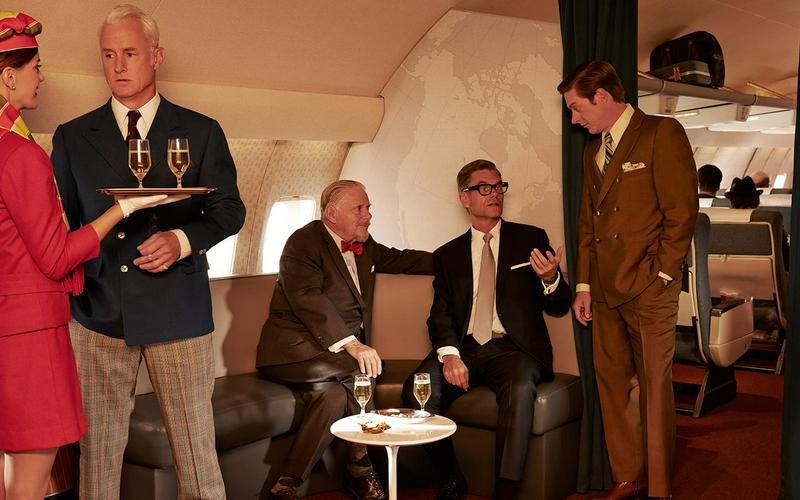Smoking On Airplanes: Unreal Facts And Stories About When Smoking On Planes Was Outlawed
By | November 15, 2019

Air travel has seen many changes since the days of Mad Men, getting on a plane meant getting suited and booted for the occasion. Today, we're lucky if people keep their shoes on. Flight attendants of yesteryear more closely resembled cocktail waitresses, and coach still meant first-class service and a meal.
However, undoubtedly the biggest change at 35,000 feet since that groovy era is the air quality in the cabin. When people still thought a cigarette was no more harmful than a glass of wine with dinner, flights were filled with chain-smoking passengers. It's impossible to imagine people smoking on airplanes today, however, thanks to the first President Bush, who outlawed stogies in the friendly skies on November 21, 1989. Here are some unbelievable facts and stories from a bygone era.

Smoking Made Flying Safer
The idea that flaming tar could make flying safer is laughable but absolutely true. It has to do with the tiny cracks in an airplane's fuselage that tend to form when the craft is hurtling through the air at 500 miles per hour thousands of feet above the ground. These cracks and holes need to be immediately detected and fixed, and those death sticks made finding them much easier. All engineers had to do was look for nicotine stains where the smoke was escaping. In 1988, when two congressmen pushed forward legislation to improve the depth of equipment checks, one of them remarked "The easiest and most common way to detect leaks in the fuselage today is to look for tobacco smoke stains on the outside metal. Not very reassuring, is it?"

How The Flight Attendants Fared
If you think that working as a flight attendant is tough today, imagine what it was like back when smoking was pervasive. According to Tracey Sear, who spent many years as a flight attendant for US Airways, it was often a dangerous game of "dodge the embers."
"I remember getting off the airplane and feeling like I had to scrape off layers and layers of ick, with eyes stinging, throat hurting and all of the other symptoms of exposure to secondhand smoke," Sear said. "Passengers would have their elbows on the armrest and then plop their hand out into the aisle with a lighted cigarette in it. So we would have to try to dodge it."

Someone's Still Smoking
Believe it or not, the days of smoking on airplanes aren't completely dead. All you need to earn the coveted privilege is a pilot's license. That's right: The purveyors of our most convenient mode of travel are still allowed to smoke, provided the plane is on autopilot. That might seem dangerous, but the reasoning behind the law is that it's actually more dangerous to force a pilot to squirm with nicotine withdrawal for hours at a time. But don't worry: Just because it's legal doesn't mean it's common. More likely than not, your pilot isn't sparking up while a brainless machine guides you through space.

So Why The Ashtrays?
Since smoking on airplanes has gone the way of the dinosaur, why are there still ashtrays onboard? Well, just because a law exists doesn't mean it’s going to be followed. Ashtrays are still required on planes for those outlaws to have a place to put out a cigarette if they try to sneak one in. They’re like security cameras: Sure, shoplifting is illegal, but businesses still need protection.

Smoking Once Saved 26 People's Lives
Cigarettes have been proven beyond a reasonable doubt to be murderers, but for 26 people in 1948, they were a lifesaver. When a Norwegian domestic flight from Oslo to Hommelvik crashed due to high winds, 19 people died, but the 26 people sitting in the smoking section located at the back of the plane just happened to be in the right place to survive. Amazingly, 76-year-old philosopher Bertrand Russell was one of them. In his autobiography, he wrote that he insisted on a seat in the smoking section because "if I cannot smoke, I should die."

Smoking Kills, Too
The luck of those smoking survivors in the 1948 flight was obviously an aberration. In 1973, a flight from Brazil to France never made it to its destination because one passenger just had to get his smoke on. A fire broke out in the rear of the plane, thought to have been started by a passenger throwing his butt into the trash can, forcing the plane into a crash landing in a field roughly three miles from the runway. Only 10 crew members and a single passenger survived after they escaped through the emergency exit at the top of the cockpit. This tragedy is why "no smoking" placards were added to aircrafts, but it's worth noting that the only reason the lone passenger lived was because he refused to heed instructions to stay in his seat. Moral of the story: Always follow the rules, but sometimes, don't.

